


 |
September 14, 2017: A Day Tour Around the Île d'Orléans |
 |
September 12, 2017: Our First Half Day in Quebec City |
 |
Return to the Index for Our Trip to Quebec City |
This morning I got up early and the young ladies at the front desk called a taxi for me. I took that taxi out to the Enterprise Rent-a-Car office where I had reserved a 7-passenger vehicle for our next two days here. (As it turned out, I might have been able to have such a vehicle available at the downtown office, which was within walking distance of the hotel, but I didn't know that at the time.) When I get back with the vehicle, we will be taking it out northeast along the St. Lawrence to Montmorency Falls, the Church of Sainte-Anne-de-Beaupré, and then, I hope, the Canyon of Sainte-Anne.
A Morning Walk
While I was getting the car, Fred, Prudence, and Nancy were out on a morning walk, so the first of today's pictures will be from that walk.
|
According to their pictures, their first stop was the B&B Marquise de Bassano, which, as you can see on the aerial view, is located in the heart of the historic city of Old Quebec, near the southeast corner of the Park of the Governors- in the shadow of the Château Frontenac. It is also near the Citadel of Quebec and the Battlefields Park (Plains of Abraham). The Victorian mansion that is now the B&B was built in 1888 by Lord Mount Stephen, one of the founders of the Canadian Pacific Railway. Its website says that the woodwork, stained glass, moldings, and high ceilings are all original. I am sure that the three of them would like to have seen the inside of the building while they were there.
The three of them walked on down the picturesque street and past the Park of the Governors, where Fred got a nice picture of Prudence and Nancy. When they came to the southeast corner of that park, they got their first view of the Chateau Frontenac as they continued on down to the Governor's Promenade- the broad boardwalk that leads from the Chateau Frontenac all the way to the Plains of Abraham.
|
|
For some reason, there was a sculpture on exhibit near the Chateau Frontenac that Fred took a picture of. It was by Salvador Dali and entitled "L'éléphant Spatial".
They came around the water side of the hotel, and passed by the Champlain statue which is located between Chateau Frontenac and the old city; hall and to the Place d'Armes and the Monument to the Faith, which was erected to commemorate the tercentenary of the arrival of the Récollets in Quebec City.
|
I was back with the vehicle when they returned to the hotel, so we all went into the hotel restaurant to have some breakfast. You can take a look at Fred's breakfast.
We were getting ready to head out on our day trip, so everyone went upstairs to collect what they needed and get ready to go. When they all returned, I took 'em to where I'd parked the vehicle and we headed out.
Montmorency Falls
When Fred and I were here in 2008 on our trip to Acadia National Park, we came through Quebec City and went out to the falls. But that day was cold and rainy, and that pretty much ruined the impact of the falls- and almost all our pictures, of course. Today, however, the weather is cool and beautiful, and we are looking forward to seeing them again for the very first time.
Getting to Montmorency Falls
|
|
This expressway crossed the St. Charles River and then headed northeast along the north side of the St. Lawrence River. About five miles up the expressway you come to the exit for highway 368. If you head to the right at this exit, as we will do tomorrow, you cross onto the Ile d'Orleans. But if you turn left, you will eventually come to the entrance for the "Chutes de Montmorency" (Montmorency Falls) park. (As we learned last time we were here, you can also continue on along this road to a city street that will take you up the cliffside to the top of Montmorency Falls, and I thought that we might do that after we were done at the base of the falls, but we ended up taking the tramway instead.)
We turned into the park entrance, paid our entrance fee, and drove to the parking area for the visitor center.
The Walk to the Base of Montmorency Falls
|
Right in the middle of that bridge there are unobstructed views of the falls across the small portion of the river that runs from the base of the falls to the St. Lawrence River, and we took maximum advantage of that spot to take a great many pictures. With six cameras snapping away, we ended up with lots of duplicates. The views of the falls from here were amazing, and it was tough not to include large numbers of our pictures. But I have narrowed them down to a manageable number. First, there were photos of the falls by themselves:
 (Click on Thumbnails to View) |
In addition to the normal-scale views of the falls, many of use went for closeups of the top of the falls, and a few of us went for views of the bottom.
|
Many of our pictures were, of course, of each other with the falls as a backdrop. Here are the best of those pictures:

(Click on Thumbnails to View) |
Finally, before we headed on across the bridge to the walkway to the base of the falls, here are a couple more images of the area around the falls. Below, on the left, is Fred's closeup hoto o fthe facilities at the top of the falls- including the tramway station and the hotel/restaurant. Below, right, is a movie I made panning across the area in front of us (beginning at the base of the cliff that appears in Fred's closeup photo):
|
|
From the bridge, we continued across to the other side of the river, and then turned to head along the walkway directly to the base of the falls. The closer we got, of course, the more fine mist we encountered.
|
Here some additional good pictures that we all took while walking down towards the falls (including a nice one of the stairs that are part of the hiking trail that leads up from the base of the falls and all the way around the crest of the cliff to the bridge above them):
 (Click on Thumbnails to View) |
While we were still some distance from the falls, I asked everyone to pause on the walkway ahead of me so that I could put together a panoramic view of the entire falls area, and this view takes in much of the entire Montmorency Park:

It was a beautiful day, totally unlike the cold, rainy day that Fred and I experienced on our first visit here, and so the walk from the Visitor Center to the base of the falls was very enjoyable.
|
Once on the platform, we started taking pictures, trying to keep the spray off our cameras. We did get some good pictures:
 (Click on Thumbnails to View) |
I got what I thought was one particularly nice picture of Guy and Fred with the falls as a backdrop, but I think we all got some good pictures.
|
I also made a movie, and you can use the player below to watch it:
|
Mouseover Image for Video Controls |
|
The rainbow appeared in many of our pictures, including the three more that I want to add to the album here:
 (Click on Thumbnails to View) |
At this point, I wanted to go up the wooden stairs to get some different views, but I was the only one who seemed to want to. So, since I couldn't possibly lose the group, I headed up the stairs while they began to make their way back to the visitor center.
Climbing the Stairs (and Return to the Visitor Center)
|
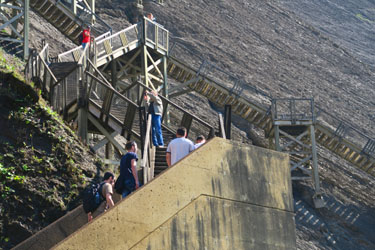 |
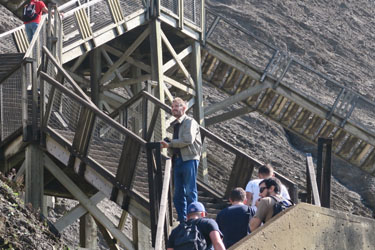 |
Climbing up the stairs was pretty neat- although it was exhausting. I am not sure if I would want to climb all the way to the top, but if I did, I'd take it slowly. I have to admit, though, that the views got better and better the higher I got. One good view was one that I captured looking back towards the Visitor Center. You can see the St. Lawrence, the Center, the pool at the base of the falls, the boardwalk where the rest of the folks were, and the set of stairs that leads down towards the walkway. Just click on the link to see that goodpicture of the area below the falls.
I enjoyed climbing about halfway up the staircase, and I took lots of pictures (and had a few taken of me as well by obliging hikers). Here are some of those pictures:
|
|
|
|
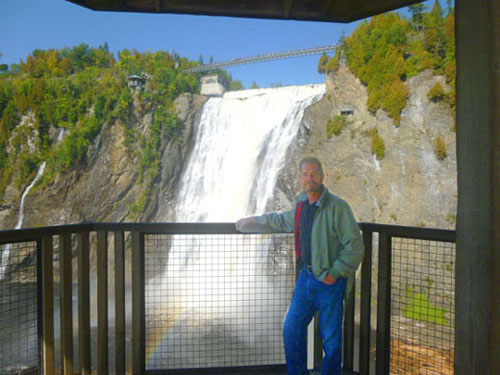 |
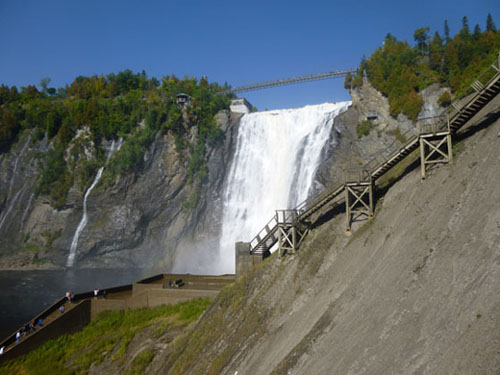 |
I went down the stairs towards the visitor center, and before I got to the bridge across the river I had met up with everyone else. On the way across the bridge back to the center, I got one more nice picture of Fred, Prudence, and Guy with Montmorency Falls as the backdrop. Then we all went back inside the center and bought our tickets for the tram ride up to the top of the falls.
The Tram Ride to the Top of the Falls
First, here are a couple of Nancy's pictures, taken at the beginning and end of the trip, both looking back down to the St. Lawrence River:
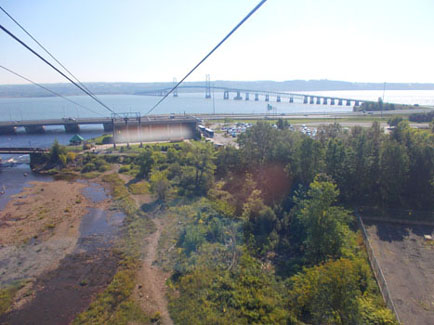 |
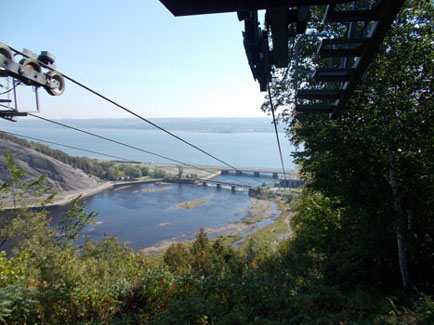 |
Maybe watching a few movies will give you a better idea of what the short trip was like.
|
(Mouseover Image for Video Controls) |
(Mouseover Image for Video Controls) |
|
(Mouseover Image for Video Controls) |
And now for the best of the pictures that Fred and I took on the way up:
 (Click on Thumbnails to View) |
Manoir Montmorency
|
From this area, there were very pretty views out across the St. Lawrence River, and across the face of the cliffside over to Montmorency Falls. The whole area was one big photo opportunity, as Prudence's portrait of Nancy and Guy shows.
We spent some time here wandering around before we headed over to the top of the falls, and when we returned we stopped to have some lunch at Manoir Montmorency. After lunch, while everyone was getting ready to head back down, I thought I would just sit in the sunshine for a while; however, I don't remember dozing off.
|
Both before and after our walk over to the falls themselves, we also took a number of pictures around the grounds of the Manoir, and I have put the best of them below:

(Click on Thumbnails to View) |
The Manoir was a nice place, but of course we had taken the tram up here to go have a look at the top of Montmorency Falls, so that is where we headed.
The Walk to the Falls
|
The path that we followed was actually a walkway that was partially at ground level and partially suspended off the side of the steep hillside. It ran from the Manoir all the way along the cliff face to an observation platform just to the side of the falls themselves (and just out of Guy's picture to the right.
Along the way there were great views out to the St. Lawrence, and we could also see, going under the walkway, some of the very small waterfalls that ran down the rock face of the cliff to the west of the main casdade.
|
Going down to that observation platform, we were treated to great views- not only of the falls, but of the area below them and out to the St. Lawrence River. Here are some of those views:
 (Click on Thumbnails to View) |
I want to include a few more pictures here that we took at and around the observation platform, and I also want to show you a good movie that I made of Montmorency Falls:
|
 (Click on Thumbnails to View) |
|
|
Now for the main event- the top of Montmorency Falls.
At the Top of Montmorency Falls
|
At left is a portion of a picture that Nancy took from back down near the Visitor Center. I have enlarged and then clipped out the part of the picture that shows the top of Montmorency Falls and the bridge that spans the river right above the top of the cascade. It was on that high perch, suspended over the top of the falls, that we were standing when our pictures and movies were taken. (You can also see the octagonal observation platform off to the left; it appears in some of our pictures from the bridge. It is hard to express how interesting it was to be standing right above the cascade, and thinking that if the bridge ever failed, each and every person on it would likely go right over the falls. The falls themselves looked, and even more importantly, sounded powerful. It was a pretty amazing experience.
The views from here were amazing. Each of us took a good many pictures, and pretty obviously we each duplicated some of the views, so I've chosen the best of the pictures we took and put them in a slideshow, so that it's easy for you to look at them.
|
|
|
The slideshow is at right.
If you don't already know, you can use the little arrows in the lower corners of each slide to move from one picture to the next. And you can track your progress through the slideshow by using the index numbers in the upper left corner of each slide.
Enjoy looking at the views from the top of the Montmorency Falls bridge!
Fred and I took quite a few movies here on the bridge, and as you might imagine, there was a lot of duplication here, too. I don't think you need to watch three of four movies of the cascade itself, or of the vista out to the St. Lawrence, or of anything else in particular. So I have whittled the movies down to just three- one looking all around the bridge area (including upriver), one of the powerful cascade beneath our feet, and a third that Fred took of a zipliner going across the face of the falls. I think you will enjoy all three.
|
(Mouseover Image for Video Controls) |
|
(Mouseover Image for Video Controls) |
(Mouseover Image for Video Controls) |
On the far side of the bridge, there is an area where you can go down to the river itself to a kind of overlook. From there, you can look upstream at the automobile bridge that crosses the river above the falls, and you can also look back at the footbridge; there are really neat views looking at the falls going underneath that bridge. This overlook was a good place to take pictures, as you might assume.
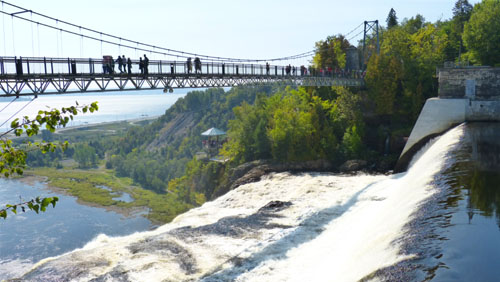 |
 |
So, after weeding out the duplicate pictures again, there aren't so many that a slideshow is called for, so just have a look at these pictures using the thumbnails below:
 (Click on Thumbnails to View) |
We really enjoyed just relaxing here at the overlook at the far end of the bridge. The views were tremendous, and being beside flowing water is always a treat. I actually flirted with the idea of walking back to the Visitor Center by following the path through the woods and around the top of the ridge to the stairs down to the observation platform at the base of the falls. But I did not know how long that might take, and since we were together as a group, and not all of us would want to do that, I thought better of it, and stayed with the group as we returned across the bridge.
|
Before we left the overlook, though, I made a movie of the Montmorency River as it flows under the bridge and over the falls, and you might want to watch it:
|
Mouseover Image for Video Controls |
We returned to Manoir Montmorency and had our lunch. The food was really good, and the sun was warm and inviting, so we had a great time before we returned to the tram.
|
|
If you are ever in Quebec City, don't miss Montmorency Falls. I reviewed it highly on Trip Advisor, not because I think that Mother Nature will read it and be pleased, but because I want as many visitors as possible to come and experience it. If you come and visit, though, I wish you a morning like this one, and not the cold and rain of our previous visit.
Done here, we piled into the car and we headed off to the Basilica of Sainte-Anne-de-Beaupré.
The Basilica of Sainte-Anne-de-Beaupré
One of the stops we had put on our agenda for the two days when we would have a vehicle was the Basilica of Sainte-Anne-de-Beaupré, in the eponymous town further east along the shore of the St. Lawrence River. The Basilica of Sainte-Anne-de-Beaupré is only a few hundred feet from the the St. Lawrence Rivera about 19 miles from Quebec City. It has been credited by the Catholic Church with many miracles of curing the sick and disabled. It is an important Catholic sanctuary, which receives about a half-million pilgrims each year. Since 1933 they have included members of the Anna Fusco Pilgrimage from Connecticut. The peak period of pilgrimage is around July 26, the feast of Saint Anne, the patron saint of Quebec.
Getting to the Basilica of Sainte-Anne-de-Beaupré
|
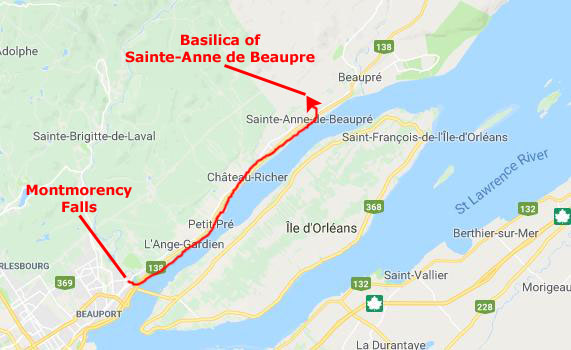 |
We turned off the highway just before the Jerusalem Cyclorama, and drove just a few hundred feet to find an open parking space right in front of the Basilica. We got out, made sure our cameras were ready, and headed off to tour the Basilica. We did so much here, and took so many pictures, that I'll group them into sections. We didn't stay together, either, and so many of us visited the same part of the Basilica independently, and so when I group the pictures, just be aware that they weren't all taken at the same time.
The Plaza and Fountain
|
The basilica in Sainte-Anne-de-Beaupré was initially a shrine to honour Saint Anne. Saint Anne, of David's house and line, was, of course, the mother of Mary and grandmother of Jesus according to apocryphal Christian and Islamic tradition. Mary's mother is not named in the canonical gospels, nor in the Quran. In writing, Anne's name and that of her husband Joachim come only from New Testament apocrypha, of which the Gospel of James (written perhaps around 150) seems to be the earliest that mentions them.
On March 8, 1658, settler Etienne de Lessard donated two frontal acres from the west end of his property to the Catholic Church, so that a chapel could be built. This chapel eventually became the site of the modern-day basilica. The chapel was built to provide a place of worship for the new settlers in the area and to house a miraculous statue of St. Anne.
The first reported miracle at the site happened during the shrine’s construction. A man named Louis Guimond was hired to help build the shrine even though he suffered from rheumatism. After placing three stones upon the shrine’s foundation, Guimond was cured of all his ailments. This was followed by other testimonies of healed people, and the shrine soon grew in popularity. Many pilgrims came to the shrine hoping to receive a miracle while others, like Anne of Austria, wife of Louis XIII and Queen of France, supported the shrine from a distance. As you can see in the couple of pictures so far, the basilica is pretty impressive. It was certainly more impressive, at least from the outside, than the Basilica of Notre Dame we visited in Montreal. Perhaps some of that is due to the fact that this church stands apart from other structures and has a large fountain in front of it.
In front of the basilica, a beautiful fountain welcomes pilgrims. Installed in 2008, for the celebration of the 350th anniversary of the Shrine, this fountain reaches a height of ten meters. Water flows over the scalloped lips of a bronze basin of some 4 meters in diameter. At the summit is a statue representing Ste Anne and her daughter, Mary.
|
|
  (Click on Thumbnails to View) |
After we visited the fountain and plaza, we went over to the church itself, and it was here that we kind of split up. I paused at the top of the basilica's front stairs to take a picture looking back at the plaza.
The Basilica Building: Front
Because of the popularity of the shrine, the building was enlarged several times to accommodate all the pilgrims. In the late nineteenth century, a basilica was constructed around the shrine. In 1876, the first basilica opened for worship. This was destroyed in a fire on March 29, 1922. The present-day basilica was built in 1926 on the site of the prior church.
|
 |
 |
 |
 |
 |
 |
You can also see that the entire facade is covered with intricate and beautiful carved stone. In this picture of Guy with the facade behind him, you can see much of this carving- including the basilica's "Rose Window". Here are closer views of these carved elements:
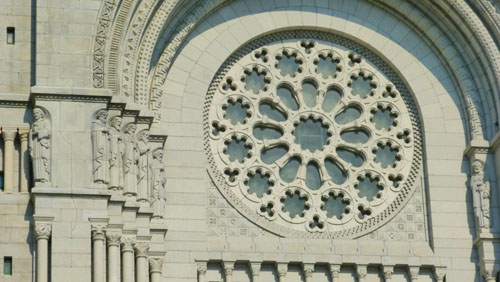 |
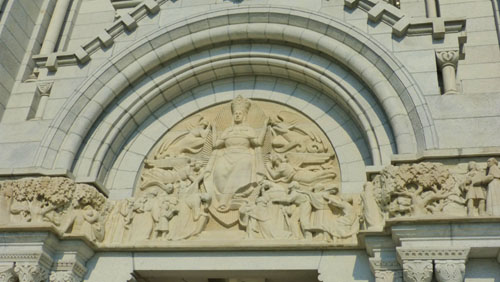 |
In that second picture, the main carving in the middle of the facade was actually part of one continuous carved element, as the ribbon carvings on either side continued across the facade. Here is a composite picture of that carved element:
 |
The main doors of the Basilica are hand-made of copper and they present many scenes of the life of Jesus. This exceptional work of art created by the artist Albert Gilles was originally hanging on the doors of the St. Joseph Church in Quebec City in the 1950s. The three double doors alone represent 12 months of laborious work. After the closing of this church in 2003, Albert Gille’s masterpiece was given a second chance at life when it was transferred to the Saint Anne de Beaupré Basilica the same year, to the great benefit of pilgrims and visitors.
Here you can see the three sets of doors inset into archways, and when we got close to them, we could see that they were made of beaten copper. Here are Prudence and Fred beside one of these sets of doors. Each door in each set had two copper panels; I believe these panels were the same on each set of doors, but I confess I never went to check. Finally, above each set of doors there was a wider panel that spanned the width of the doors. These panels were very nicely done; here are the four panels from the set of doors where Prudence and Fred were photographed:
|
|
|
|
I want also to add two more pictures of the central part of the facade- one from Nancy and one from me. I also made a movie of the facade, and I wanted to include it here also.
|
|
|
To give credit where credit is due, architects Maxime Roisin, Louis N. Audet and Joseph-Égilde-Césaire Daoust collaborated on the project for building the basilica from 1923-1931, when the Great Depression brought work to a standstill. After the end of the Great Depression, work on the facade (and the interior) resumed in 1937; the facade was completedd at the outbreak of World War II, and the interior was finally completed in 1946.
The Basilica Building: Side
|
Pilgrims are attracted from across Canada and the United States. Miracles are still believed to occur at the basilica. Two pillars near the entrance are filled with racks of crutches, canes, braces, and other signs of disabilities. Each item has been left by a pilgrim who reports being healed at the basilica.
The wooded hillside next to the basilica has a memorial chapel and a Way of the Cross, with life-sized Stations of the Cross. Higher up the hill the Convent of the Redemptoristines can be found. Built in 1906 and declared a historic site in 2001, it no longer operates as a convent and has essentially been abandoned in the early 21st century.
After examining the exterior of the beautiful basilica, I went on inside to see what it was like. This was when I got separated from everyone else, but when appropriate, I'll aggregate their pictures with my own.
The Narthex
|
One of the two areas had a crucifixion as its focal point, while the other one seemed to have a mosaic depicting Jesus' entry into Jerusalem- perhaps a Palm Sunday theme. In my picture of that shrine, I did not get a good picture of the mosaic on the back wall, but Fred did- and that picture is at the immediate left.
One one wall, Nancy got a picture of another copper panel- a feature that the rest of us apparently missed. Looking at her picture, I wasn't sure what the subject of the panel was, but she fortunately also took a picture of the top plaque next to it- so you can read that plaque here. There were other decorative elements on the walls around the narthex; here are some of them:
|
|
|
|
Most of the decoration in the narthex turned out to be mosaics- particularly on the lintels over the doorways and windows and on the floors. On the lintels, the theme seemed to be the zodiac, except that the labels were the months of the year (in French, of course). The zodiac signs don't correspond exactly with the months, but I guess it's close enough. Between us, we photographed only seven of the months, and here they are:
 (Click on Thumbnails to View) |
There were other mosaics on the ceiling and above the doors leading into the nave. Here are some of those colorful mosaics:
 (Click on Thumbnails to View) |
In addition to the mosaics on the ceilings and walls, there were also mosaic designs on the floor. At one end of the narthex, there was this intricate design, and there was an almost-duplicate design at the other end of the long anteroom. In the middle, there was a series of individual mosaics. I thought these were interesting, in that the subjects of the designs seemed to have nothing to do with religion. Rather, they seemed to be designs depicting the secular world- and mostly, I think, they depicted occupations in that world- occupations such as shipping, journalism, woodworking, and so on. I found this a bit unusual, and am not sure what the purpose was, except perhaps to "ground" this particular church squarely in the day-to-day life of its parishioners. Here are some of those secular-themed mosaics:
 (Click on Thumbnails to View) |
From the narthex, we next visited the nave (although as I mentioned before we have gotten separated from each other and weren't all in the nave at the same time, even though I will aggregate all our pictures of it in a single section).
The Nave
|
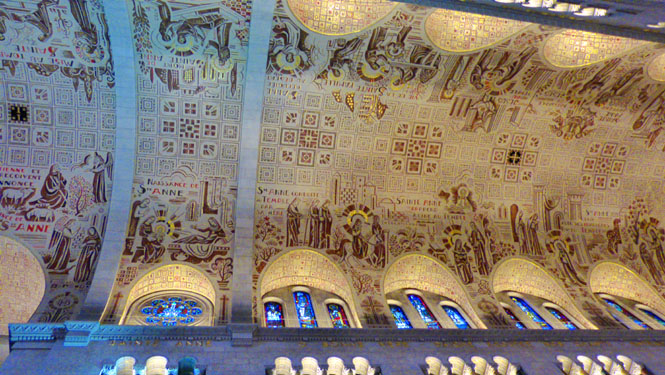 |
I was struck by the difference between the decoration in this church and that we have seen in churches elsewhere. It seemed as if here the focus was on the everyday life of the community; there was much depiction of normal people doing normal things, and also a focus on historical figures from the area. It almost seemed as if the decoration was intended to glorify man, not the "gods".
|
|
This church was very much different from the Notre Dame Basilica that we'd visited in Montreal; this church had more of a "Protestant feel" to it.
Here is another view of the altar and ceiling at the front of the nave.
We took quite a few good pictures inside the nave; here are a selection of them:
 (Click on Thumbnails to View) |
Here are three mosaics we found on the nave floor:
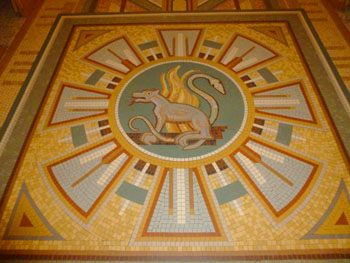 |
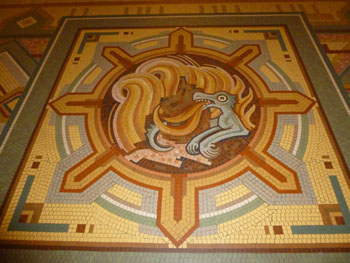
| 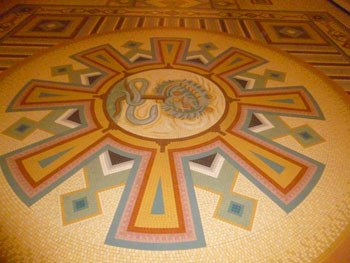 |
More views in and around the nave:
 (Click on Thumbnails to View) |
As with many churches we have visited, the Basilica of St. Anne de Beaupre had a rose window at the back of the nave (the front of the church). This was just one of may stained glass elements that we found in this basilica. They lined the nave on both sides. Again, many of them had "common" themes, or were symbolic of real places in Canada and elsewhere.
|
|
Between us, we took pictures of almost all of the stained-glass windows. We had to take them from a distance, as they were quite high in the walls, but even so many of the pictures turned out well. I have put the best of these pictures in the slideshow at left. As usual, you can move though the images by clicking on the "backward" and "forward" arrows in the lower corners of each image. (They can be hard to see, but if you mouseover one of them you will see it highlighted.) You can track your progress through the images by referring to the index numbers in the upper left corner of each image. The beautifully decorated Chapels surrounding the Sanctuary were built before the Second Vatican Council, at a time when each Priest would celebrate daily Mass on an individual basis. Above all the Chapels is a large mosaic illustrating the history of the Eucharist in the Church. This mosaic extends around the Sanctuary as a crown above the ten Chapels. Each Chapel is dedicated to a different Saint that has made a significant contribution in the Church. Among them were St. John the Baptist (the patron saint of French Canadians), St. Joachim (the husband of Saint Anne), St. John Baptiste de la Salle (1651-1719, and the founder of the Christian Brothers), St. Benedict (480-547, and founder of the Benedictine Order), St. Joseph (chosen to be the father of Jesus and the patron saint of Canada), St. Patrick (385-461, the patron saint of Ireland), St. Gerard Majella (the patron saint of expectant mothers), and St. Alphonsus Liguori (founder of the Redemptorists, who have been the guardians of this shrine since 1878). There were also chapels dedicated to Mary (Our Lady of Perpetual Help) and to the Eucharistic Heart of Jesus. I've put our photographs of these chapels in the slideshow at right. Again, use the arrows in the lower corners to move through the images, and track your progress with the index numbers in the upper right.
|
|
The nave was quite beautiful, but there was more to the shrine downstairs.
The Immaculate Conception Chapel

The huge, cavernous room was pretty amazing, with an altar and organ at one end, and at the other (underneath the facade of the church) the two doors that led up to the narthex. I thought that the graceful, curved, arched ceiling was pretty neat, and the "gothic" and graceful sweeping ribbed ceiling quite beautiful. Here are some pictures of the room itself:
 (Click on Thumbnails to View) |
|
As capitals for the columns, there are 176 small mosaics that can be admired, representing birds, flowers, butterflies, all small things but so pretty, reminding once again of all nature, creation of a generous God who shows us his love through all these beauties. These were quite beautiful, and Prudence, in particular, liked them very much, and she spent some time photographing a small number of them. I have put her photographs below. To see the larger version of each image, just move your mouse over the thumbnail images at the left; the larger image will show up at the right. I have used one of the images as a placeholder at right.


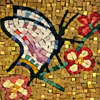

|
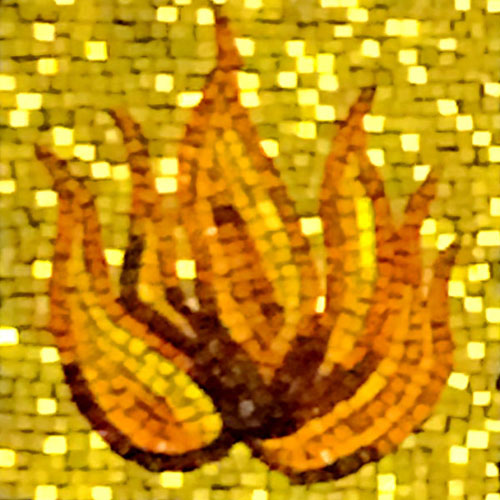
|
On the way out of the basement hall, we passed another, smaller chapel, so we stopped in to look.
The Blessed Sacrament Chapel
|
Here are some other views of the chapel and its decoration:
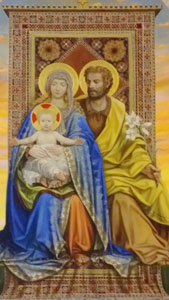 |
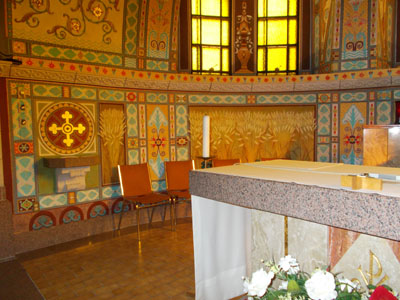 |
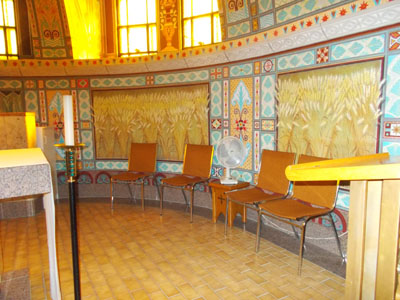 |
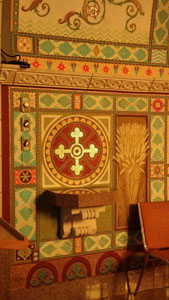 |
We went up the stairs to an exit on the south side of the basilica to end our visit.
Outside the Basilica- South Side
|
The round structures contained some of the small chapels that were off the nave, and of course you can see the rounded structure at the back of the church surrounding the altar. You can also see a porte d'cochere at the back of the church and a small portion of the souvenir shop.
As with many churches we have been in, this one had an aisle that went around behind the altar and sacristy, and some of the many chapels were to be found there.
As Guy was still occupied for a while, I walked south from the basilica almost back to the highway to where I could look back and get a side view of the basilica in a single shot.
When I rejoined everyone, we headed back to the front of the church where Prudence got another excellent view of the facade of the basilica- glowing in the afternoon light. At the northwest corner of the basilica property, there were a few small stores and antique shops which, I presume, usually cater to visitors to the basilica. Prudence and Nancy wanted to go look in the store windows, and some of us stopped in for some ice cream and a cold drink- which we consumed sitting on benches in front of the basilica. Here are a few pictures of these stores- and of us:
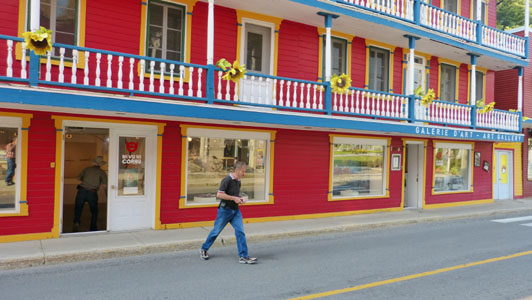 |
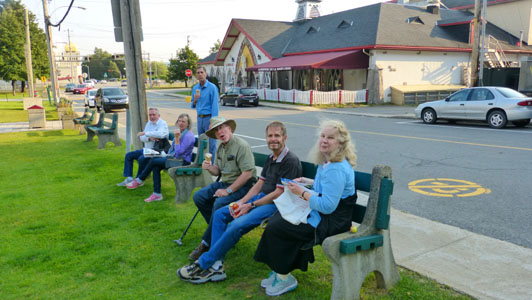 |
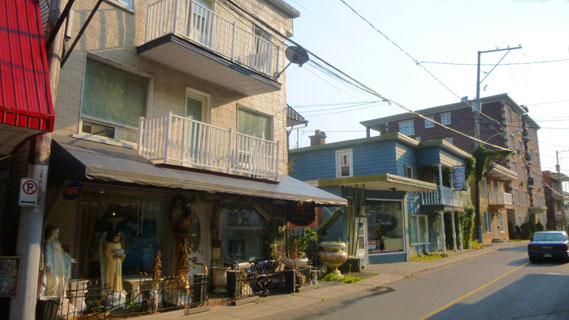 |
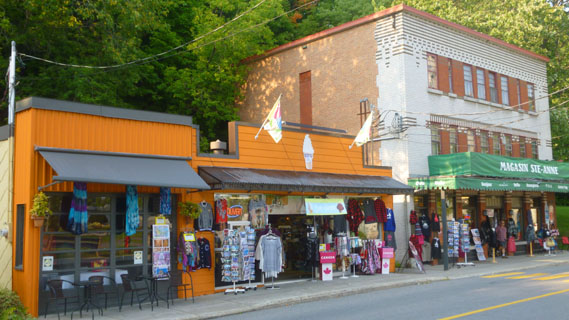 |
When we left the basilica, I drove further east, intending to take everyone to the Canyon de Ste. Anne, about five miles further along past the actual town of Beaupre. When we got to the turnoff for the road to the canyon, we discovered that it was actually a park that closed at 5PM; we were about a half hour too late to enter. If we return here again, perhaps we can visit the canyon; there is a rope bridge that it would be fun to traverse, and I understand that the canyon itself, while not the Grand Canyon or anything, is still quite picturesque. We ended up just driving back to Quebec City.
The Plains of Abraham
Yesterday, right after we arrived in Quebec City and had checked in to the Manoir d'Auteuil, we walked over to the large park on the cliffs overlooking the Saint Lawrence River- the Plains of Abraham. It had been a long walk, so we didn't go all the way to the river, but since we have a vehicle today, we thought that we would go ahead and drive right over to the St. Lawrence, park, and spend some time walking around.
|
The plains are likely named after Abraham Martin (1589–1664), a fisherman and river pilot who moved to Quebec City in 1635 with his wife Marguerite Langlois and received 32 acres of land from the "Company of New France". There are numerous references to him in city records- including a 1734 plan that precisely locating an Abraham Street. The phrase "the plains of Abraham" appeared in notable journals and even in the diaries of British soldiers.
The park itself is a mile and a half long and about a half-mile wide, extending westward from the Citadel of Quebec and the walls of Quebec City along a plateau above the Saint Lawrence River, and forms a part of The Battlefields Park. There is an interpretive center and walking trails, and monuments commemorating the Battle of Sainte-Foy and James Wolfe (the latter being an astronomic meridian marker raised in 1790 by the Surveyor-General of Canada, Major Holland, on the site where Wolfe was said to have died). There is also the Cross of Sacrifice we saw yesterday, memorializing the soldiers who were lost in World War I.
The park is quite nice, and certainly convenient for anyone who lives downtown (and a lot of people do). Of course, I am sure that one reason so many people visit the park is that it offers expansive views of the river:
|
|
|
We went over by the overlook and found that there were beds of late-season flowers, which, of course, Prudence and Fred photographed. Of course, we could not resist using the St. Lawrence River as a backdrop- particularly for a couple of pictures of Prudence and Ron.
|
Below are some of the other pictures that we took here at the overlook this evening:

(Click on Thumbnails to View) |
When we left the overlook, we had to take the one-way road through pretty much the length of the park, heading west. There were lots of people in the park this evening- picnicking, playing ball, or just enjoying the pleasant weather. There also seemed to be some sort of fun run going on.
We came out on the Grand Allee at the west end of the park, and then we drove back to the hotel where I found a place to park on the street.
That brought our first full day in Quebec City to an end. We relaxed and had drinks at the hotel before heading out to look for a restaurant for dinner. We ended up at a nice one over by the Chateau Frontenac. We will be keeping the SUV one more day so that we can take a tour around the Île d'Orléans, a large island east of the city in the St. Lawrence River.
You can use the links below to continue to another photo album page.
 |
September 14, 2017: A Day Tour Around the Île d'Orléans |
 |
September 12, 2017: Our First Half Day in Quebec City |
 |
Return to the Index for Our Trip to Quebec City |